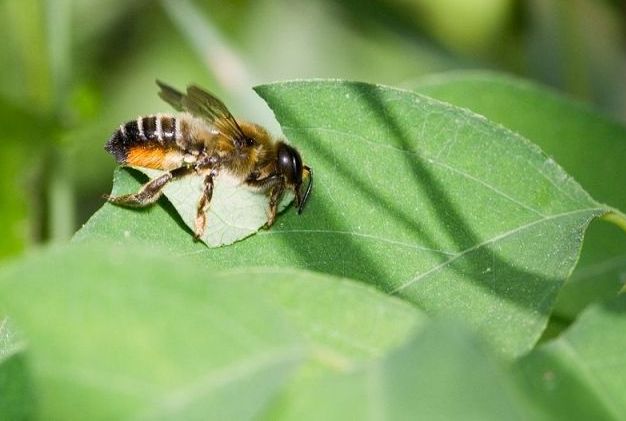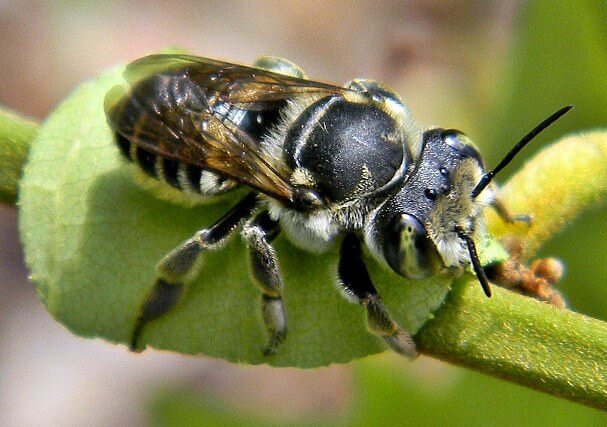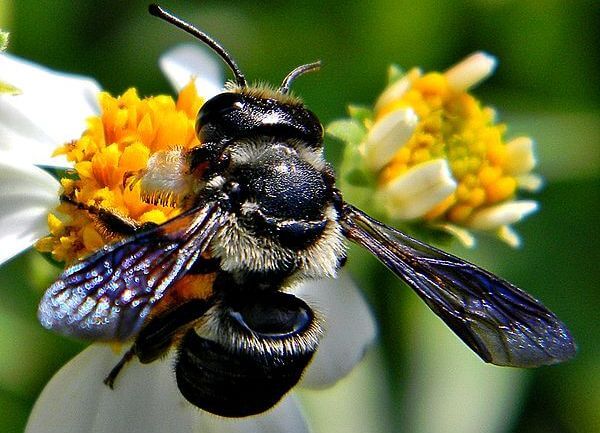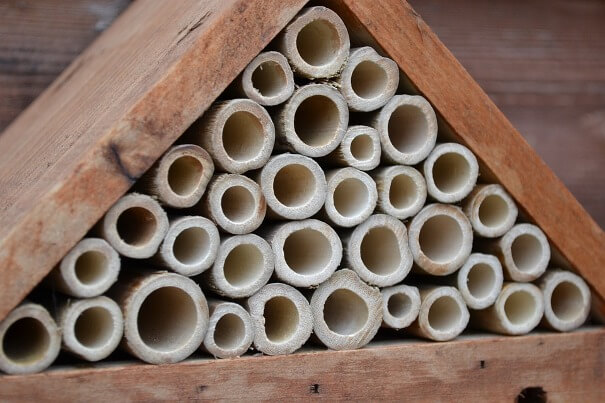Welcome! (Or if you’re a returning reader, welcome back!)
Let’s introduce you to a special someone — the leafcutter bee. Pretty straightforward name, as you’ll come to find out.
A critical difference between leafcutter bees and their cousins, the honeybees, is that leafcutters are solitary bees.
Translation: there are no colonies or classes in a leafcutter bee’s nest. Instead, the female(s) all raise their own young and rear their nest on their own.
Oh, and don’t be concerned if you find a leafcutter bee nest in your beloved oak tree or in your prize rose plants — they’re meant to be there.
You see, leafcutter bees like to nest in warm, moist places such as rotting wood or the stems of pithy plants such as roses.
(Pith is a spongy tissue, known as the medulla, found in vascular plants, suspected to come in handy as a storage unit for water and nutrients).
If you’ve read up on bees, you’ll see that this behavior is strikingly similar to that of mason bees (a guide about them in the works!) and indeed, the two species share a lot of common traits.
Leafcutters are a type of bee found throughout North America but are most commonly found in New England.
(New England comprises Maine, Massachusetts, Vermont, Rhode Island, Connecticut, and New Hampshire).

Are leafcutter bees harmful to my plants?
The leafcutter causes several “plant parents” concern because they wake up one morning and find a family of bees in their prize roses.
I’ll be quite plain: leafcutter bees are not harmful to humans OR plants and are usually quite beneficial.
I say “usually” because these bees are great pollinators, but they are best suited for the pollination of melons, squashes, and other fruity plants (not all gardens may have them).
That’s one of the many leafcutter bee facts you might not have come across elsewhere.
Nevertheless, you don’t want to get rid of a leafcutter bee nest if you find one because they are excellent pollinators for things like peas and cucumbers, aside from melons. (Kitchen gardens, yay!)
Aside from that, they cause no harm to plants whatsoever because they cut away only a small part of the leaves and their populations aren’t generally big enough to warrant the destruction of a whole plant, let alone your entire garden.
In fact, leafcutter bees are so good for pollination that an entire industry has been developed around them.
For instance, the alfalfa leafcutter bee is very much in demand today (it gets its name because it feeds exclusively on the alfalfa plant).
The alfalfa bees come in handy by helping the reproduction of the alfalfa plant which is then harvested for its seeds.

I want some leafcutters too!
You’re in luck: it’s easy to find leafcutter bees for sale online (but not on eCommerce sites, obviously).
That’s right — people actually sell leafcutter bees.
Since these little guys like to nest in the summer, it is relatively easy to manufacture and transport entire nests around than most other species.
You can choose to have a nest home delivered to you with or without the leafcutter bee cocoons inside.
If you don’t want to risk the cocoons dying, you can order just the nest, and dot it with leafcutter bee attractants (chemicals that are sold separately).
That said, people do farm these bees, and lots of homemakers choose to have leafcutters over honeybees mainly because they’re more docile.
You can find a leafcutter nest with 200+ cocoons listed online for about $35.

The life cycle of a leafcutter bee
The life cycle of a leafcutter bee is not the same as most other bees (birth, work, death).
Being from the Megachile family, leafcutters are a solitary species of bee.
This means that they have no hierarchy of caste systems like social bees like honeybees and their distant relatives, the yellowjacket wasps.
The leafcutter be “mom” makes her nest in the summer and stocks each individual cell with enough food to last through the winter.
When the winter is over, the leafcutter bee larvae inside the cells hatch and begin their new life. The mother is probably long dead by this time, and it’s up to the little babies to fend for themselves.
The mothers find a place to nest, and then begin creating a network of cells by using semicircular pieces of leaves to divide each cell from the next.
These bits of “nest leaf” become the larvae’s cocoons that keep them warm in the winter.
I should point out that although these bees are solitary, they’re still very social. Let me explain.
We call leafcutter bees “solitary” because they do not have a caste hierarchy but they are still very socially active among their peers.
For example, female leafcutter bees will often next extremely close to each other and will sometimes help other females build their nests too.
This increases the chances of survival for each nest a lot and helps the population of leafcutters grow faster than other species.
Now, leafcutters don’t store honey (like other solitary bees), but instead, make a pollen and nectar paste that they leave within each cocoon to feed the larva inside cells.
Read here: How is Honey Made
The “stinging” question – leafcutter bees
I hope you’ll pardon the pun, but yes, people do tend to ask if leafcutter bees sting, and the answer is: maybe.
See, being a solitary bees, they are not aggressive in the least.
That said, they do sting when handled sometimes, but even then, their sting is much milder than that of a honeybee.
In fact, the University of Florida has said that leafcutter bees “do not pose a stinging danger to humans” and also says that a leafcutter sting is “far less painful” than the bite of a wasp.
Yes, bee-lieve it or not, leafcutter bees will not go out of their way to attack.
You know, personally, I think that bees have been given a bad reputation because some guy decided to chuck a rock at a nest.
Much like most other animals, you leave bees alone, and they won’t bother you in return.
Leafcutter bee identification
Identifying a leafcutter bee isn’t too hard: just picture a honey bee with lighter stripes and a lighter shade of black on its body.
The females are larger than the males, and leafcutter bees generally range from 6mm to 25mm in size, though most are moderately sized.
The females of the species (aside from being larger in size) have a triangular abdomen that thins down to a point.
The males, on the other hand, have a much more blunted abdomen and longer antennae than the females.
Leafcutter bee house DIY
In this section, you’ll learn how to build a suitable house to observe these leafcutter bees at work, all from scratch!
Now, when going the DIY route, you can go one of two ways: wood nests or container nests.
If you decide to use wood to construct your nest, it’s perfectly alright to use spare/ waste lumber from your garage.
I’ve seen a lot of people go out of their way to buy fancy timber just to construct bee habitats — even though the bees don’t care about such frills.
Oh and another thing is that if you decide to paint your wooden beehive, let the paint cure for at least a month before putting it to use.
Reason: leafcutter bees are very sensitive to smell, and the odor of wet paint (however slight it may be) can be enough to repel the bees.
On the other hand, if woodworking isn’t your jam, you can also use various containers that are lying about your house.
These include PVC pipes, Pringles containers, small mugs (anything that has three closed sides and one opening).
Step 1: Clean your container with water.
Step 2: Line the container with nesting materials.
Step 3: Place some colorful objects near/ on your container because bees orient themselves through visual cues.

Things to remember when DIY-ing your leafcutter bee nest:
- Avoid using bamboo for the nesting material, because bamboo is too wide for most bee species, and is hard to open.
- Also, avoid using plastic straws because they too are hard to open.
- Fleshy reeds work best for the nesting materials.
- You can also use paper to line the nest.
- If you’re drilling holes manually in your reeds, make sure to not drill all the way through: there should only be one opening.
- Leafcutter bees like nests with hols that are ~6mm wide. Any more and other bees will take over the nest if they find it.
- Install the nest about 5 feet off the ground (at eye level), near fresh blooms, and close to a source of clay (which they use to build the rest of their hive).
- A water source (like a birdbath or pond) near the hive is advisable.
That’s pretty much all there is to know about leafcutter bees, they don’t sting unless handled and only forage about 100m (300 feet) from their hive.
They are a solitary, but socially active species of bee that thrive in moist places during the summer.
You can buy them online for as little as $30 to help pollinate your beloved squash patch, and the only plant part that they harm is the aesthetics.
Oh and technically, these bees build nests, not hives, as the scientific community has told us.
The leafcutter bee larvae love the warm, gooey inside of the plant or tree trunk log where they can wiggle about happily and feast on the pollen their parents give them. (Yum!)
Read here: